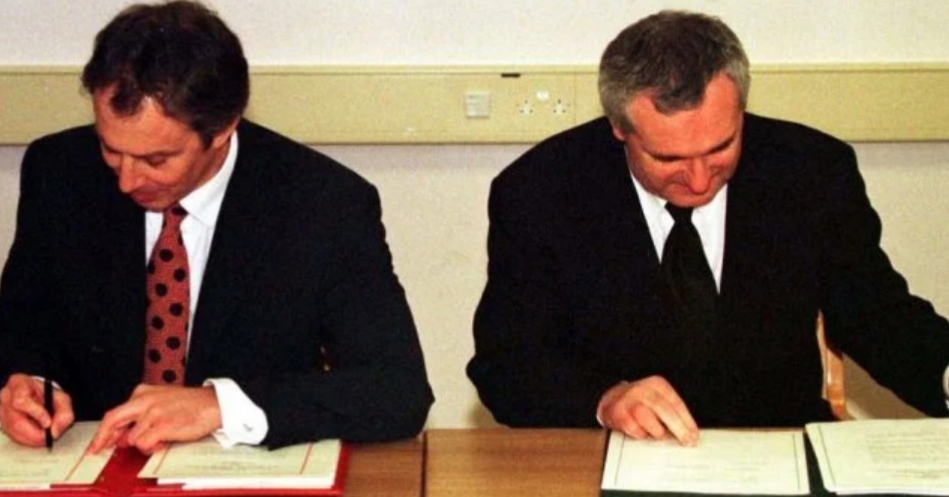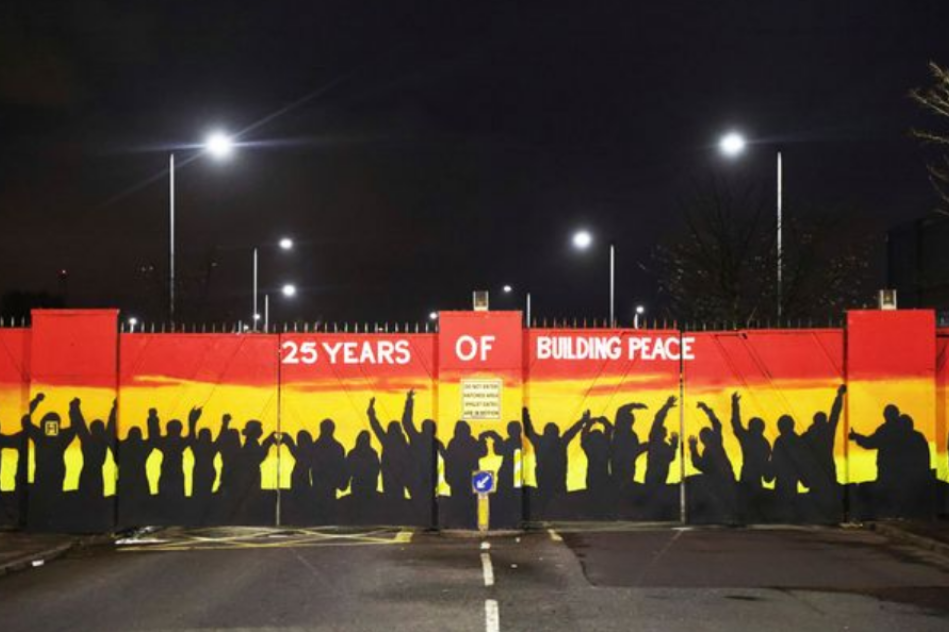
2023 marks the 25th anniversary of the signing of the Good Friday Agreement (GFA). Recognised in Ireland and beyond as the beginning of peace on the island, the GFA introduced a multi-faceted peace-process which is still in effect today. However, 25 years on from the signing of the agreement, Northern Ireland continues to experience episodes of sectarian violence, calling the agreement’s ability to create long-standing and sustainable peace into question. While grassroots peacebuilding efforts are generally considered to be more successful in achieving cross-denominational cooperation, this bottom-up approach is also not without its challenges. In this entry marking the 25th anniversary of the agreement, I will outline its contents and examine the challenges faced by grassroots peace building efforts in Northern Ireland.
The GFA is not a single document but rather a pair of agreements: the Multi-Party Agreement between most of Northern Ireland’s political parties, and British-Irish Agreement between the governments of the Republic of Ireland and Britain. Signed on the 10th of March 1998, the GFA addresses issues of Northern Ireland’s sovereignty and governance, the demilitarisation of the region and paramilitary disarmament, and the commitment to police reform, among other conditions. The people of Northern Ireland were asked to vote on the Multi-Party Agreement and a similar referendum was held in the Republic of Ireland. Because signing the GFA would cause substantial change to the Irish constitution, amending articles 2 and 3 to recognise Northern Ireland as a British territory for the first time, the people of the Republic of Ireland were also invited to vote on whether they would accept the GFA. Both referendums supported the Agreement with an overwhelming majority, and the GFA came into effect on the 2nd of December 1999. As well as putting a symbolic end to the troubles, the constitutional changes in Ireland and the repeal of the UK’s Government of Ireland Act 1920 (a law which enabled the partition of Ireland in the early 20th century and laid claim to the territory of the entirety of the island of Ireland), mandated by the GFA, marked a positive change in British-Irish relations.
The GFA is composed of three strands, each dealing with a different aspect of Northern Ireland’s development. The first strand deals with the status of Northern Ireland within the UK and covers the formation of the Northern Irish Assembly and Northern Ireland Executive, the backbone of devolved government, and power sharing in the region. The second strand is concerned with ‘north-south’ issues, between Northern Ireland and the Republic. This section of the agreement governs organisations such as the North/South Ministerial Council, which has the power to exercise whole-island policies, creating greater co-operation between North and South. The final part of the agreement, strand three, deals with ‘east-west’ relations between the Republic of Ireland and the United Kingdom, establishing shared governing bodies such as the British-Irish Intergovernmental Conference, which gives the Republic a say in matters of governance in Northern Ireland, which are not devolved to Stormont.
However, 25 years after the Agreement was signed, MI5’s terrorism threat level indicator still describes Northern Ireland as a step above the rest of the UK, and violent attacks still plague the community. Although March 2022 saw the threat level reduced from ‘severe’ to ‘substantial’ for the first time since 2010, recent activities such as the attempted murder of DCI Caldwell have caused the level to be restored to ‘severe’, almost exactly one year later.[1] ‘The main threat comes from dissident Irish Republicans, like the so-called New IRA, still pursuing Irish unity by violent means,’ writes David Blevins, Sky News’ Senior Ireland Correspondent, ‘But loyalists, who bitterly oppose the Brexit border in the Irish Sea, have also threatened violence if it isn’t removed. With no power-sharing government in place, there’s a political vacuum and there will always be those who seek to fill it.’[2] The political uncertainty in the region is a concern to many, raising questions about the efficacy of the GFA in creating long-lasting sustainable peace in Northern Ireland, with many eyes turning to grassroots operations.
Nicola Browne’s research on grassroots peacebuilding in Northern Ireland reveals a landscape full of contradictions. While she found that grassroots operations possess ‘untapped potential in developing connections between traditionally divided communities through social, economic, and environmental campaigns’, she adds that grassroots peace building campaigns ‘can be obstructed by some who are invested in by peace funds – who appear to be motivated by territoriality and by preserving that investment.’[3] Browne’s research has the potential to be quite alarming, as she suggests that grassroots peace-building structures in Northern Ireland are also affected by sectarianism and border lines. While it is fair to say the GFA has not succeeded in entirely ‘fixing’ the problem of sectarian division in Northern Ireland, Browne’s research does not paint its top contender, bottom-up peacebuilding, in an entirely hopeful light, questioning the ability of bottom-up operations to remain impartial, given their reliance on external funding. Despite recognising the enormous healing power of grassroots peacebuilding operations, Browne makes it clear that current systems of bottom-up peacebuilding in the region are not yet been optimised for function. Hence, while the development of bottom-up peacebuilding in Northern Ireland is exciting and has greater potential for achieving intersectional cooperation in the future than the GFA, systemic issues in the structure of such grassroots organisations must be addressed to optimise their efficacy.
The 25th anniversary of the Good Friday Agreement brings with it both celebration and challenges. While the frequency and severity of violence in the region have calmed since the signing of the Agreement, the area is still not entirely peaceful, with a recent uptick in attacks post-Brexit. Grassroots and community peacebuilding programs have captured the public’s imagination in recent years as a means of enhancing the power of the Agreement, and have proven to be successful, calling for a development in peace-building protocols. However, grassroots peace-building brings its own set of difficulties, as funding and territory play major roles in the development of peace campaigns. Although it is uncertain what the next 25 years will bring for Northern Ireland, further investigation of the mechanics of grassroots peace-building seems like a step in the right direction.

What do you think?
- Can top-down peace-building operations create sustainable peace in post-conflict societies or are grassroots operations also necessary in building long-lasting peace?
- How might grassroots peace-building organisations be restructured to mitigate issues of funding-based bias?
- Are community-run grassroots programs susceptible to local ideological influence as well as funding-based bias? If so, how might this be counteracted?
- How do you think peace-building in Northern Ireland will continue to evolve in the next 25 years? What kinds of resources and support would you like to see?
- How does the ‘peace level’ or ‘threat level’ in Northern Ireland impact on the wider region?
If you enjoyed this item in our museum…
You might also enjoy Colombia: The long road to peace, Get Your Brits Out, The Wolfe Tones, Cambridge Union Debate, Generation Peace, Creating Peace in Post-Conflict Society, Imperfect Justice via Gacaca in Rwanda, and Two Neighbours.
Aimée Capraro, April 2023
References
1.See: Faye Brown, “MI5 raises terror threat in Northern Ireland to ‘severe’-meaning attack highly likely,” Sky News, March 28, 2023, https://news.sky.com/story/mi5-raises-terror-threat-in-northern-ireland-to-severe-meaning-attack-highly-likely-12844127. See also: Stephen Murphy, “Northern Ireland terror threat level lowered for first time in 12 years,” March 22, 2022, https://news.sky.com/story/northern-ireland-terror-threat-level-lowered-for-first-time-in-12-years-12572654.
2. David Blevins, Senior Ireland Correspondent, Sky News, quoted in: Faye Brown, “MI5 raises terror threat in Northern Ireland to ‘severe’-meaning attack highly likely,” Sky News, March 28, 2023, https://news.sky.com/story/mi5-raises-terror-threat-in-northern-ireland-to-severe-meaning-attack-highly-likely-12844127.
3. Browne, Nicola, “Keeping the Peace: Conversations with Grassroots Activists, Executive Summary.” Change from the ground up, accessed April 13, 2023, https://static1.squarespace.com/static/5f8efef8e3608f620e6c73ee/t/617abbcf80813a20f28abe7c/1635433426097/Keeping+the+Peace+Exec+Summary.pdf.